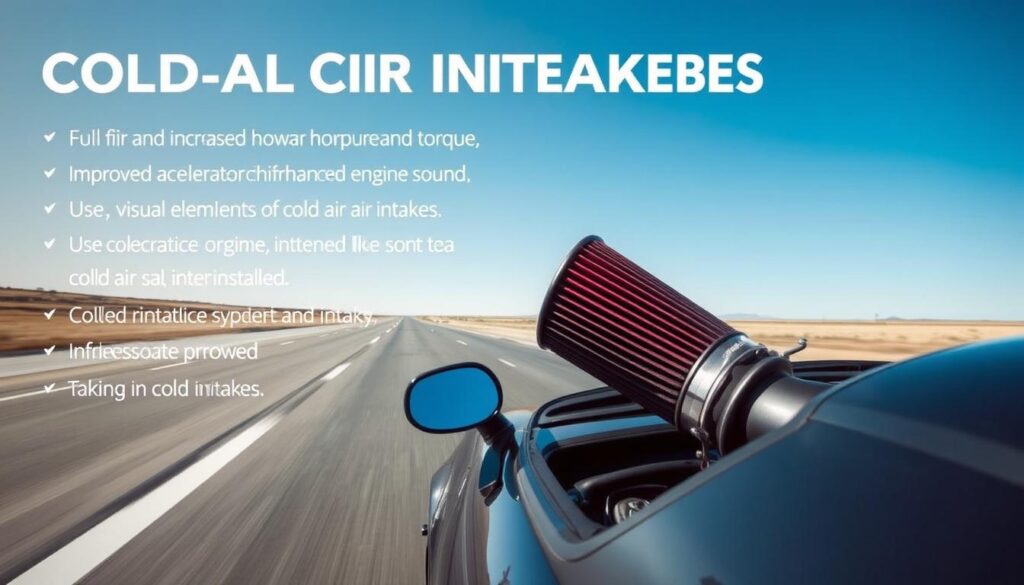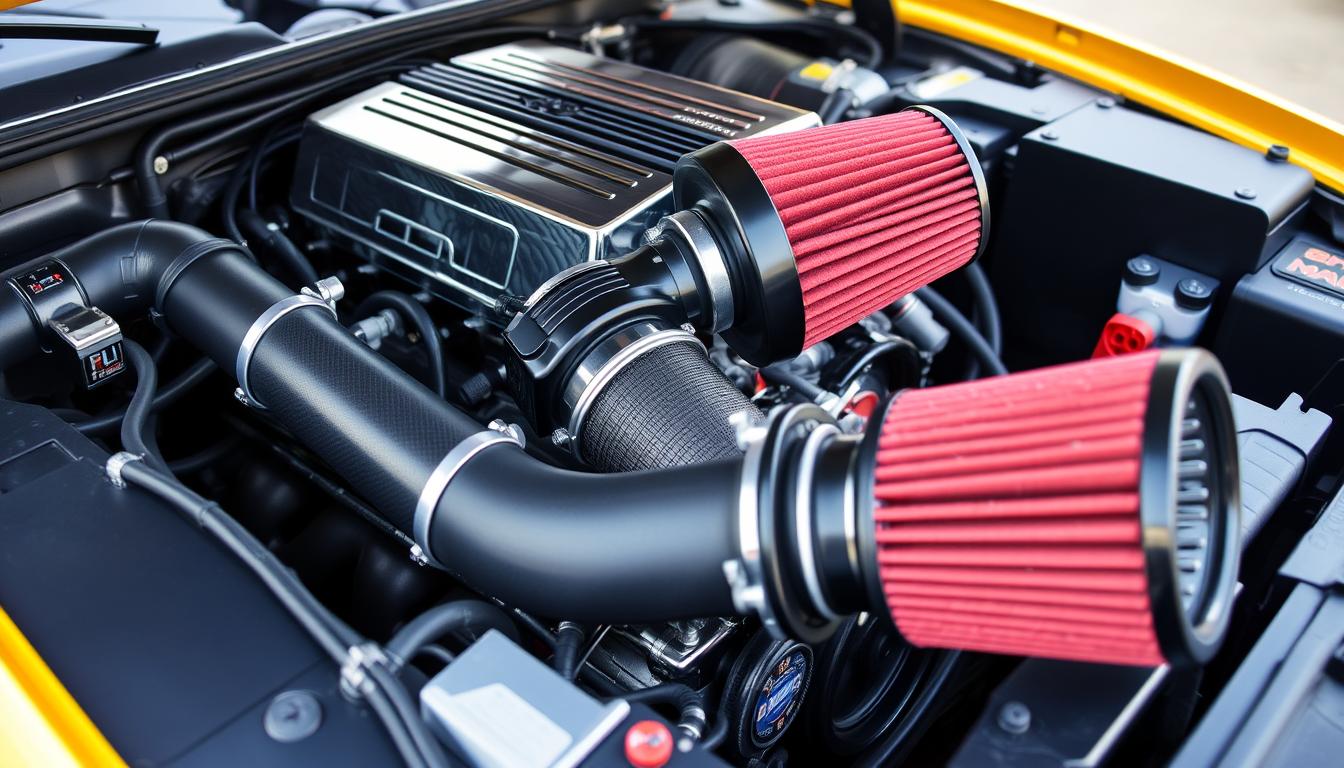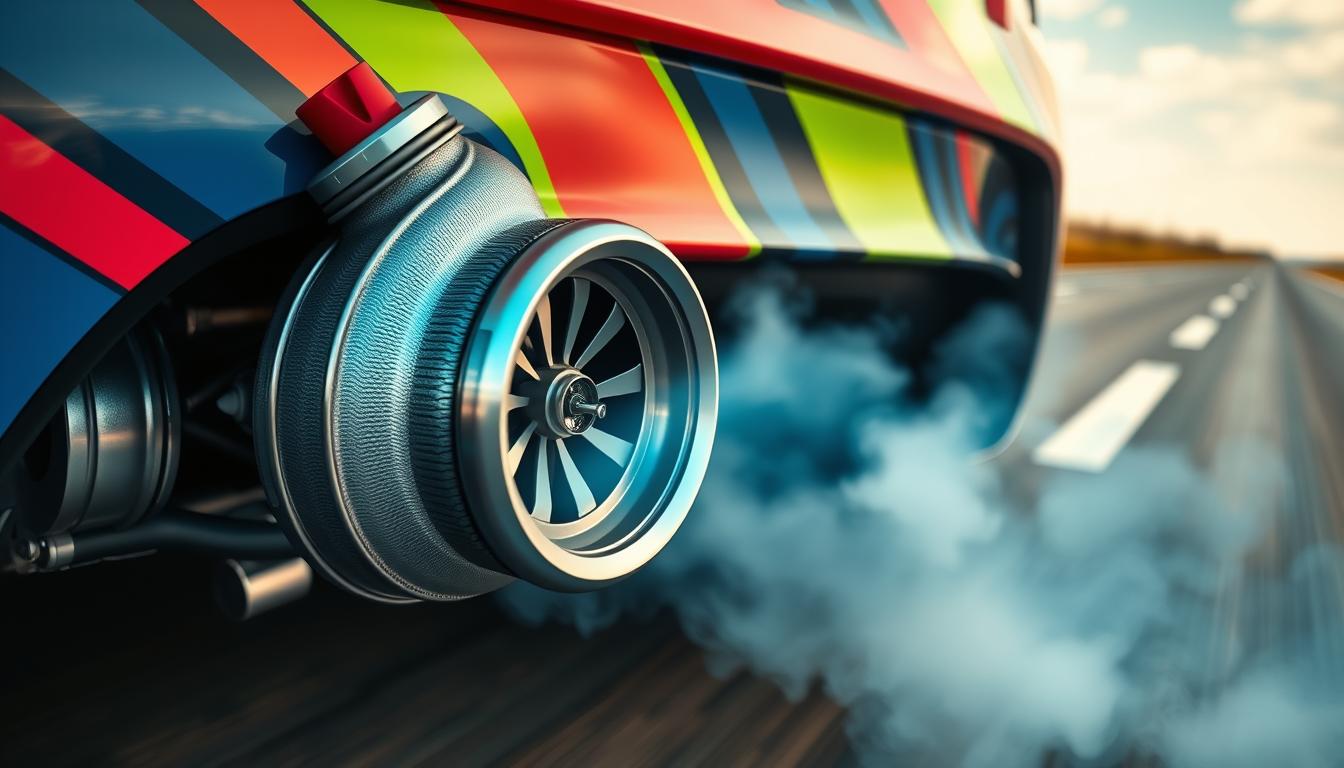Imagine holding the steering wheel tight, feeling your car move swiftly with every command. You hit the gas, and you hear a powerful sound, not just any engine noise. This is how it feels to drive a car with upgraded parts. Upgrading your air intake system gives that powerful boost you’re looking for. By doing so, you’re not just changing parts; you’re enhancing your engine’s power.
Starting this improvement journey brings cooler, cleaner air into your engine. This leads to better combustion and increases in horsepower, speed, and gas mileage. Knowing the advantages of a cold air intake system turns your car into the thrilling ride you dream of.
Key Takeaways
- Upgrading your intake system enhances airflow, resulting in improved engine performance.
- Cold air intakes deliver cooler, denser air for better horsepower and efficiency.
- Short ram systems are cost-effective while providing noticeable horsepower gains.
- Custom intakes are tailored for specific vehicles to maximize performance.
- Maintaining an upgraded air intake system leads to long-term benefits in fuel economy and reliability.
Understanding Air Intake Systems
An air intake system is key for your vehicle’s engine health and performance. It channels air into the engine, a must for combustion. The system’s type and quality greatly affect your vehicle’s performance.
What is an Air Intake System?
An air intake system is how air gets to the engine. It has parts like filters and tubes to send clean, cool air. This cool air has more oxygen, boosting engine efficiency and combustion.
With better airflow, the engine’s fuel-air mix improves. This leads to better performance all around.
Why is a Good Air Intake System Essential?
A top-notch air intake system is crucial for a few reasons:
- Enhanced Engine Efficiency: A good system boosts airflow, enhancing combustion and power.
- Performance Upgrades: Upgrading your intake system can make your car accelerate faster and respond quicker.
- Fuel Efficiency Improvements: Vehicles with better intake systems often use fuel more efficiently.
- Increased Longevity: Cooler air helps reduce engine wear, possibly making it last longer.
Knowing these parts and their effects helps you choose updates wisely. No matter your driving style, understanding the value of a good air intake system is the first step to upgrades.
Key Components of an Air Intake System
Knowing the key parts of an air intake system shows how each helps your vehicle perform better. The air filter, intake manifold, MAF sensor, and throttle body are crucial. They ensure your engine gets the right amount of air for perfect combustion.
The Role of the Air Filter
The air filter keeps bad particles like dust out of the engine. It’s crucial for your engine’s performance and life. Cleaning the air filter regularly boosts airflow. This lets your engine “breathe” better. You’ll notice an uptick in horsepower and enjoy your rides more.
Importance of the Intake Manifold and MAF Sensor
The intake manifold has a big job: it evenly divides air to every cylinder. The MAF sensor then measures this air. Together, they make sure your engine gets the perfect mix of air and fuel. This mix is vital for good combustion. A well-matched intake manifold and MAF sensor make your engine run smoothly. They also help in burning fuel completely, cutting down emissions.
How the Throttle Body Affects Performance
The throttle body plays a big part in managing the engine’s air intake. It adjusts air flow based on how fast you want to go. This affects how quickly your car responds and its overall zippiness. A bigger throttle body can boost air flow. This means better acceleration and a quicker response when you hit the gas. Upgrading this part can greatly improve your car’s performance during fast drives.

| Component | Function | Impact on Performance |
|---|---|---|
| Air Filter | Filters out debris from entering the engine | Improves horsepower, fuel efficiency |
| Intake Manifold | Distributes air to cylinders | Enhances combustion efficiency |
| MAF Sensor | Measures incoming air volume | Ensures optimal air-fuel mixture |
| Throttle Body | Regulates airflow into the engine | Affects responsiveness and acceleration |
The Role of Cold Air Intakes
Cold air intakes (CAIs) are popular for enhancing engine performance. These systems feed cooler, denser air into the engine. This improves combustion efficiency and benefits the vehicle.
How Cold Air Intakes Work to Improve Performance
Cold air intakes move the air filter outside the engine area. This lets cooler air into the engine. Cooler air has more oxygen, boosting the combustion process. So, vehicles with a CAI often see:
- Increased horsepower
- Faster acceleration
- Improved throttle response
- Better fuel efficiency
A clean, efficient air intake system boosts air pressure. This optimizes fuel combustion. Long-distance drivers might save on fuel costs.
Benefits of Installing a Cold Air Intake System
Installing a CAI offers many benefits. Here are some key cold air benefits:
- Power Gains: CAIs give more horsepower than short ram systems.
- Increased Fuel Efficiency: The fuel efficiency boost is small but adds up over time.
- Enhanced Engine Longevity: Cooler temperatures reduce engine strain, extending its life.
- Sound Improvement: A CAI makes the engine sound deeper and more exciting.
- Durability: CAIs are made of quality materials for long-lasting use.

When picking a CAI, check the brand reputation and customer reviews. This helps you choose a CAI that maintains performance without harming your engine. A CAI might be just what you need for better performance or fuel efficiency.
Benefits of Enhanced Airflow
Improved airflow in your car’s engine offers many perks that make driving better. It boosts your car’s power while using fuel more efficiently. Knowing these benefits is key.
Increased Power and Acceleration
Upgrading your air intake system mainly boosts power increase and acceleration. Cooler, denser air improves the air-to-fuel mix, giving your engine more power. A cold air intake changes the airflow path to draw in cooler air, increasing oxygen levels. This boosts:
- Horsepower, making acceleration more thrilling.
- Throttle response, for swift acceleration with little effort.
- Power by 5 to 20 horsepower with common cold air intake upgrades.
Improved Fuel Efficiency and Throttle Response
Enhanced airflow also means better fuel efficiency. Efficient combustion lets the engine use fuel better. So, engines with upgraded intakes:
- Achieve better gas mileage, going further on each gallon.
- Benefit from throttle body spacers for small gains in power and fuel economy.
- Stay cooler, lengthening engine life and cutting down maintenance costs.

Investing in air intake upgrades leads to amazing driving and improves your car’s performance. The gains, from power increase to better fuel mileage, show why enhanced airflow matters.
Increased Horsepower and Torque
Understanding how air intake affects your car’s power is key. A good air intake system brings in colder, denser air. This boosts the combustion process in the engine. As a result, you could see a 10-20% increase in horsepower and torque. This is why modifying your intake system is a smart choice for better acceleration and responsiveness.
Understanding the Relationship Between Air and Power
Improving your air intake system can greatly change how your car performs. With bigger tubes, air gets into the engine better. This means more power and better torque, especially when speeding up or towing. Upgrades like these work well for many cars, including Chevrolet Camaro, Ford Mustang, or a Dodge Challenger. Brands like K&N or Injen have cold air intakes that really boost your car’s capabilities. In fact, 9 out of 10 users notice a big improvement in their vehicle’s performance after upgrading.
Potential Gains from Upgrading Intake Systems
The aftermarket intake system market is growing steadily, with a 5-7% annual increase. Upgrades are most common in cars made after 2010. People are looking for better horsepower and torque. Adding a new intake system does more than enhance your drive; it could also raise your car’s resale value. Understanding these benefits shows that improving your air intake system is more than an upgrade. It makes driving much more enjoyable.










